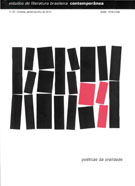O desafio nos cordéis:
lutar com as palavras não é luta vã
Abstract
Neste artigo sobre a arte verbal do cordel, parte da pesquisa de doutorado O gênero do cordel sob a perspectiva crítica do discurso, examino a utilização das diversas vozes presentes em um texto. Esse recurso assume especial importância nos cordéis, para conferir maior dramaticidade a estes e, em consequência, prender a atenção do leitor/ouvinte. Para compreender esse mecanismo, utilizo-me do referencial da análise do discurso, na formulação de Fairclough e de Martin e Rose, e da Linguística Sistêmico-Funcional, como formulada por Halliday. Com base na comparação entre o uso do discurso direto e do discurso indireto, verifi ca-se o quanto a luta com palavras (semelhante à peleja e ao desafi o) confere vivacidade e dramaticidade à s narrativas em cordel.
Downloads
References
BAKHTIN, Mikhail (1997). Estética da criação verbal. 2. ed. São Paulo: Martins Fontes.
BARROS, Leandro Gomes de (s.d.). A peleja de Manoel Riachão com o Diabo.___
____ (1986). “O boi misterioso”. In: PROENÇA, Manoel Cavalcanti. Literatura popular em verso: antologia. 2. ed. Rio de Janeiro: Fundação Casa de Rui Barbosa.
______ (s.d.). O cavalo que defecava dinheiro. Edição de João Martins de Athayde (Ed. Proprietário), Recife.
BORGES. J. Francisco (s.d.). A moça que dançou depois de morta. Edição do autor, s.l.
BONFIM, J. B. B. (2009). O gênero do cordel sob a perspectiva crítica do discurso. Tese (Programa de Pós-Graduação em Linguística), Universidade de Brasília, Brasília.
FAIRCLOUGH, Norman (1995). Critical discourse analysis. Londres: Longman.
______ (2003). Analysing discourse. Londres: Routledge.
FERREIRA, Jerusa Pires. (1993). Cavalaria em cordel: o passo das águas mortas. 2. ed. São Paulo: Hucitec.
FOWLER, Roger (1993). Language in the news. Londres: Routledge.
GARCIA, Othon (2006). Comunicação em prosa moderna: aprenda a escrever, aprendendo a pensar. 26. ed. Rio de Janeiro: FGV.
HALLIDAY, M.A.K. (1994). An introduction to systemic functional grammar. Londres: Arnold.
______ (2004). An introduction to systemic functional grammar. Londres: Arnold.
LESSA, Orígenes (1982). Inácio da Catingueira e Luís Gama: dois poetas negros contra o racismo dos mestiços. Rio de Janeiro: Fundação Casa de Rui Barbosa.
MAINGUENEAU, Dominique (1997). Novas tendências em análise do discurso. 3ª ed. Campinas : Unicamp.
MARTIN, J. R. (2000). Design and practice: enacting functional linguistics. Annual Review of Applied Linguistics, v. 20, p. 116”“126.
______ (2004). “Positive discourse analysis: solidarity and change”. Revista Canaria de Estudios Ingleses, n. 49. p. 179-202. Disponível em: <http://www.ull.es/servicios/serviciopublicaciones/index.htm>. Acesso em: 22 fev. 2009.
MARTIN, J. R; ROSE, D. (2007). Working with discourse. New York: Continuum.
______ (2008). Genre relations: mapping culture. London: Equinox.
PACHECO, José (s.d.). A chegada de Lampião no Inferno. Edição do autor, s. l.
PERELMAN, Chain e OLBRECHTS-TYTECA, Luci (1996). Tratado da argumentação. São Paulo: Martins Fontes.
SANTOS, Apolônio Alves dos (1984). “O monstruoso crime de Serginho em Bom Jesus de Itabapoana”. In: SLATER, Candance. A vida no barbante. Rio de Janeiro: Civilização Brasileira.
Downloads
Published
How to Cite
Issue
Section
License
Authors who publish in this journal agree to the following terms:
a) The authors maintain the copyright and grant the journal the right of first publication, the work being simultaneously licensed under the Creative Commons Attribution License-Non Commercial 4.0 which allows the sharing of the work with acknowledgment of the authorship of the work and publication this journal.
b) Authors are authorized to enter into additional contracts separately, for non-exclusive distribution of the version of the work published in this journal (eg publish in institutional repository or as a book chapter), with authorship recognition and publication in this journal.
c) Authors are allowed and encouraged to publish and distribute their work online (eg in institutional repositories or on their personal page) after the editorial process, as this can generate productive changes, as well as increase the impact and citation of published work (See The Effect of Free Access).
d) The authors of the approved works authorize the magazine to, after publication, transfer its content for reproduction in content crawlers, virtual libraries and the like.
e) The authors assume that the texts submitted to the publication are of their original creation, being fully responsible for their content in the event of possible opposition by third parties.


